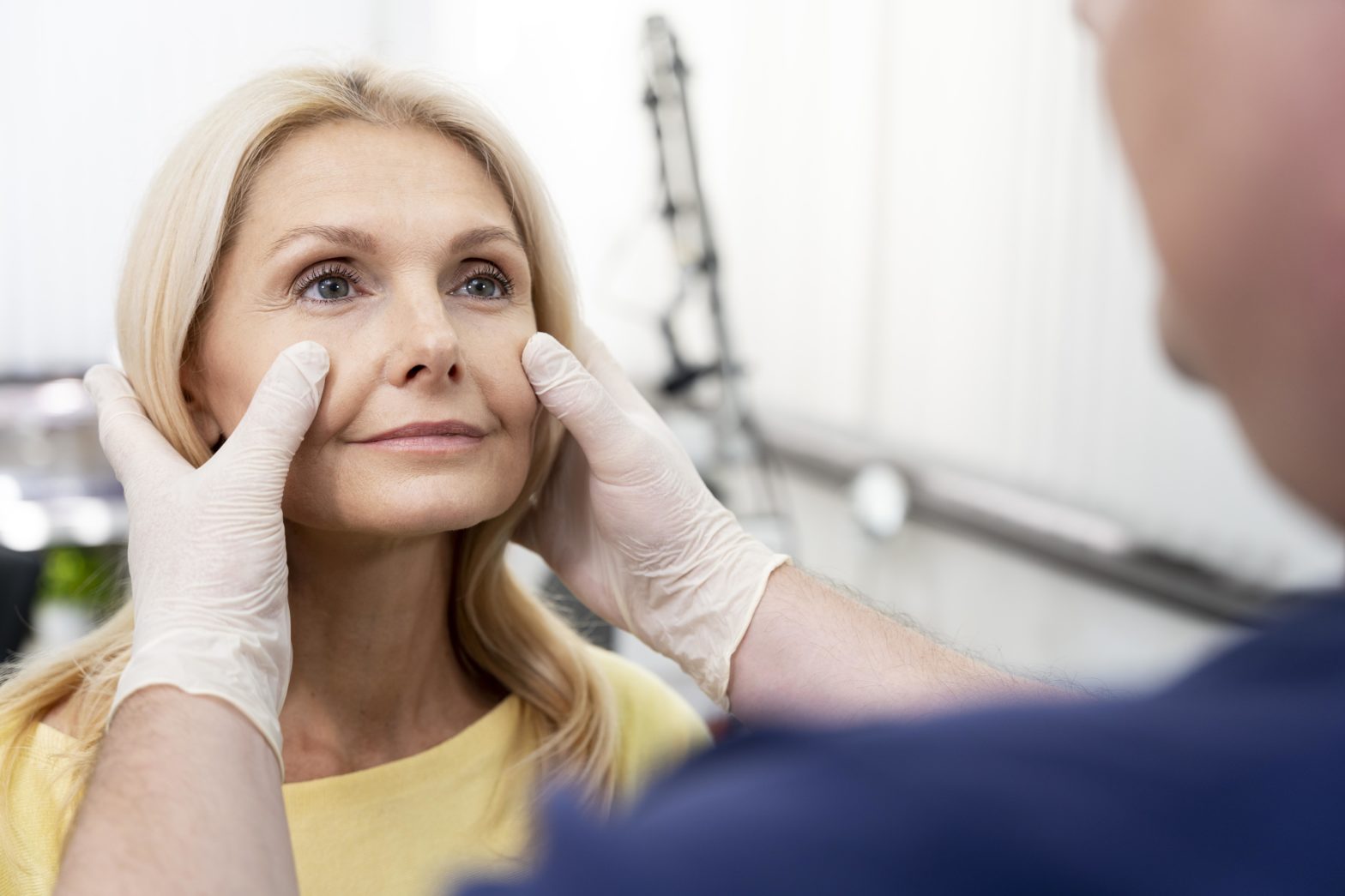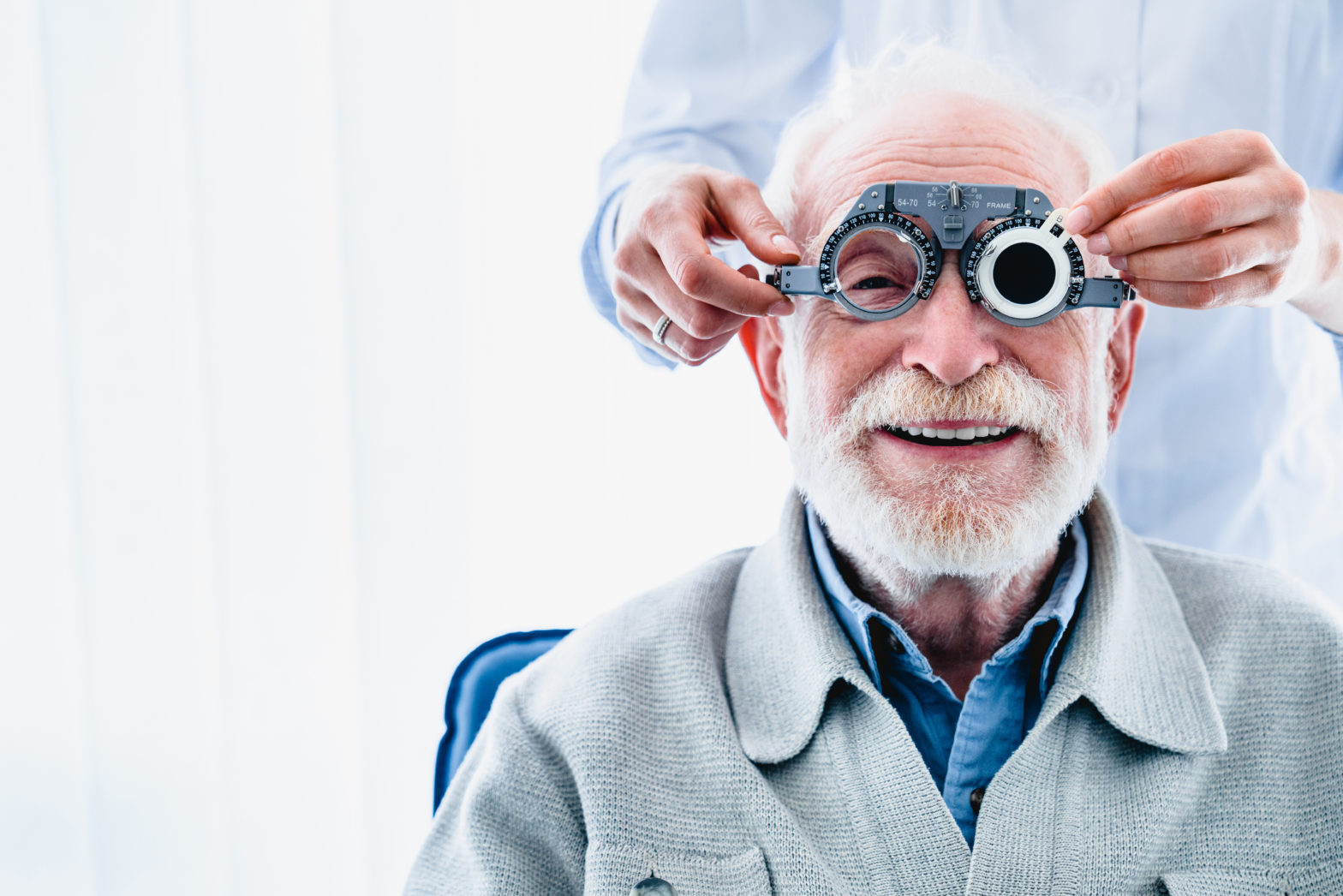தைராய்டு கோளாறுகளைப் பற்றி நாம் நினைக்கும் போது, பெரும்பாலான மக்கள் எடை மாற்றங்கள், சோர்வு அல்லது மனநிலை மாற்றங்கள் போன்ற அறிகுறிகளில் கவனம் செலுத்துகிறார்கள். ஆனால் உங்கள் தைராய்டு உங்கள் கண்களையும் பாதிக்கும் என்பது உங்களுக்குத் தெரியுமா? தைராய்டு செயல்பாட்டிற்கும் கண் ஆரோக்கியத்திற்கும் இடையிலான முக்கியமான தொடர்பைப் பற்றி பலருக்குத் தெரியாது. இந்த இணைப்பு சரியாகப் புரிந்து கொள்ளப்படாவிட்டால் அல்லது நிர்வகிக்கப்படாவிட்டால் கடுமையான சிக்கல்களுக்கு வழிவகுக்கும். இந்த வலைப்பதிவில், தைராய்டு கோளாறுகளுக்கும் கண் நிலைமைகளுக்கும் இடையிலான உறவை ஆராய்வோம், இந்த இணைப்பின் பின்னால் உள்ள அறிவியலை வெளிப்படுத்துவோம், மேலும் உங்கள் பார்வையை எவ்வாறு பாதுகாப்பது என்பதைப் பற்றி விவாதிப்போம்.
தைராய்டு சுரப்பியைப் புரிந்துகொள்வது: ஒரு விரைவான கண்ணோட்டம்
தைராய்டு கோளாறுகள் கண் ஆரோக்கியத்தை எவ்வாறு பாதிக்கின்றன என்பதைப் பற்றி ஆராய்வதற்கு முன், தைராய்டு சுரப்பியின் பங்கைப் புரிந்துகொள்வது அவசியம். கழுத்தின் முன்புறத்தில் அமைந்துள்ள தைராய்டு, வளர்சிதை மாற்றம், ஆற்றல் அளவுகள் மற்றும் பல உறுப்புகளின் செயல்பாட்டை ஒழுங்குபடுத்தும் ஹார்மோன்களை உற்பத்தி செய்கிறது. இது உற்பத்தி செய்யும் இரண்டு முக்கிய ஹார்மோன்களான ட்ரையோடோதைரோனைன் (T3) மற்றும் தைராக்ஸின் (T4) ஆகியவை உடலின் ஒட்டுமொத்த சமநிலையை பராமரிப்பதில் முக்கிய பங்கு வகிக்கின்றன.
பொதுவான தைராய்டு கோளாறுகள் மற்றும் அவற்றின் அறிகுறிகள்
தைராய்டு கோளாறுகள் பல வடிவங்களை எடுக்கலாம், அவற்றில் மிகவும் பொதுவானவை:
- ஹைப்போ தைராய்டிசம்: போதுமான தைராய்டு ஹார்மோன் உற்பத்தி செய்யப்படாத ஒரு செயலற்ற தைராய்டு. அறிகுறிகளில் எடை அதிகரிப்பு, சோர்வு, மனச்சோர்வு மற்றும் குளிர் சகிப்புத்தன்மையின்மை ஆகியவை அடங்கும்.
- ஹைப்பர் தைராய்டிசம்: அதிகப்படியான தைராய்டு ஹார்மோன்களை உற்பத்தி செய்யும் அதிகப்படியான தைராய்டு. அறிகுறிகளில் எடை இழப்பு, பதட்டம், படபடப்பு மற்றும் வெப்ப சகிப்புத்தன்மை ஆகியவை அடங்கும்.
- கிரேவ்ஸ் நோய்: ஹைப்பர் தைராய்டிசத்திற்கு வழிவகுக்கும் ஒரு தன்னுடல் தாக்கக் கோளாறு, மேலும் இது தைராய்டு-கண் தொடர்பில் குறிப்பிடத்தக்க பங்களிப்பை அளிக்கிறது.
இந்த இரண்டு நிலைகளும் கண்கள் உட்பட உடலின் பல்வேறு பாகங்களுக்கு நீண்டகால விளைவுகளை ஏற்படுத்தும்.
தைராய்டு-கண் இணைப்பு: அது எப்படி நடக்கிறது
சரி, தைராய்டு பிரச்சினைகள் உங்கள் கண்களை எவ்வாறு பாதிக்கின்றன? தைராய்டு சுரப்பியின் வளர்சிதை மாற்றத்தை பாதிக்கும் திறன், எந்தவொரு ஏற்றத்தாழ்வும் வீக்கத்திற்கு வழிவகுக்கும் மற்றும் கண்களைச் சுற்றியுள்ள திசுக்களைப் பாதிக்கும் என்பதாகும். இதற்கு மிக முக்கியமான உதாரணம் தைராய்டு கண் நோய் (TED), இது கிரேவ்ஸ் கண் மருத்துவம் என்றும் அழைக்கப்படுகிறது.
தைராய்டு கண் நோய்
TED என்பது ஒரு தன்னுடல் தாக்கு நோயாகும், இது முதன்மையாக ஹைப்பர் தைராய்டிசம் உள்ள நபர்களை, குறிப்பாக கிரேவ்ஸ் நோயால் பாதிக்கப்பட்டவர்களை பாதிக்கிறது. இருப்பினும், இது சாதாரண தைராய்டு செயல்பாடு அல்லது ஹைப்போ தைராய்டிசம் உள்ளவர்களிடமும் கூட ஏற்படலாம்.
நோயெதிர்ப்பு அமைப்பு கண்களைச் சுற்றியுள்ள திசுக்களைத் தாக்கும்போது, அது வீக்கத்திற்கு வழிவகுக்கிறது, இது பல அறிகுறிகளை ஏற்படுத்துகிறது, அவற்றுள்:
- வீங்கிய கண்கள் (எக்ஸோப்தால்மோஸ்): இது TED இன் மிகவும் புலப்படும் அறிகுறிகளில் ஒன்றாகும், மேலும் இது கண் இமைகளை முன்னோக்கித் தள்ளும் வீக்கத்தால் ஏற்படுகிறது.
- வறண்ட கண்கள்: வீக்கம் கண்ணீர் உற்பத்தியைப் பாதித்து, வறட்சி, எரிச்சல் மற்றும் அசௌகரியத்திற்கு வழிவகுக்கும்.
- இரட்டைப் பார்வை (டிப்ளோபியா): கண்களைச் சுற்றியுள்ள தசைகள் வீக்கமடைவதால், அவை ஒருங்கிணைக்க சிரமப்படலாம், இதனால் இரட்டைப் பார்வை ஏற்படும்.
- கண் வலி மற்றும் அசௌகரியம்: TED உள்ள நோயாளிகள் பெரும்பாலும் கண் குழியில் வீக்கம் மற்றும் அழுத்தம் காரணமாக வலியை அனுபவிக்கின்றனர்.
- ஒளி உணர்திறன்: வீக்கமடைந்த திசுக்கள் கண்களை ஒளிக்கு அதிக உணர்திறன் கொண்டதாக மாற்றும், இதனால் அசௌகரியம் மற்றும் கண் சிமிட்டல் ஏற்படும்.
ஹைப்பர் தைராய்டிசம் உள்ளவர்களுக்கு TED அதிகமாகக் காணப்பட்டாலும், ஹைப்போ தைராய்டிசம் உள்ளவர்கள் அல்லது சாதாரண தைராய்டு அளவுகள் கூட உள்ளவர்களுக்கு கண் பிரச்சினைகள் ஏற்படலாம். இந்த அறிகுறிகளின் தீவிரம் மாறுபடும், மேலும் சரியான மேலாண்மை இல்லாமல், அவை நீண்டகால சேதம் அல்லது பார்வை இழப்புக்கு வழிவகுக்கும்.
தைராய்டு கோளாறுகள் கண் ஆரோக்கியத்தை ஏன் பாதிக்கின்றன?
TED-க்கான சரியான காரணமும், தைராய்டு சுரப்பி கண்களைப் பாதிக்கும் காரணமும் இன்னும் முழுமையாகப் புரிந்து கொள்ளப்படவில்லை. இருப்பினும், தைராய்டு கோளாறுகளின் தன்னுடல் தாக்க தன்மையுடன் இது தொடர்புடையது என்று விஞ்ஞானிகள் நம்புகின்றனர். நோயெதிர்ப்பு அமைப்பு கண்களைச் சுற்றியுள்ள திசுக்களைத் தவறாகத் தாக்கி, வீக்கத்திற்கு வழிவகுக்கிறது.
கூடுதலாக, ஹைப்பர் தைராய்டிசம் மற்றும் ஹைப்போ தைராய்டிசம் இரண்டும் உடலின் வளர்சிதை மாற்ற செயல்முறைகளைப் பாதிக்கின்றன, இது கண் செயல்பாடு மற்றும் ஒட்டுமொத்த கண் ஆரோக்கியத்தையும் பாதிக்கும். உதாரணமாக:
- ஹைப்பர் தைராய்டிசம்: வளர்சிதை மாற்றத்தை துரிதப்படுத்துகிறது, இது திசு வீக்கத்திற்கு வழிவகுக்கும், கண்களைச் சுற்றியுள்ள தசைகள் மற்றும் திசுக்களைப் பாதிக்கும்.
- ஹைப்போ தைராய்டிசம்: வளர்சிதை மாற்றத்தை மெதுவாக்குகிறது, இது கண்களைச் சுற்றி திரவம் தேக்கம் மற்றும் வீக்கத்தை ஏற்படுத்தும்.
கவனிக்க வேண்டிய அறிகுறிகள் மற்றும் அறிகுறிகள்
சிக்கல்களைத் தடுக்க தைராய்டு தொடர்பான கண் பிரச்சினைகளின் அறிகுறிகளை ஆரம்பத்திலேயே கண்டறிவது முக்கியம். எச்சரிக்கையாக இருக்க வேண்டிய சில ஆரம்ப அறிகுறிகள் பின்வருமாறு:
- கண்களைச் சுற்றி வீக்கம்
- சிவத்தல் அல்லது எரிச்சல்
- அதிகப்படியான கண்ணீர் அல்லது நீர் நிறைந்த கண்கள்
- உங்கள் கண்ணில் ஏதோ இருப்பது போல் உணர்கிறேன்
- மங்கலான அல்லது இரட்டைப் பார்வை
- கண்களை அசைப்பதில் சிரமம்
இந்த அறிகுறிகளில் ஏதேனும் ஒன்றை நீங்கள் அனுபவித்து, தைராய்டு பிரச்சனைகளின் வரலாற்றைக் கொண்டிருந்தால், மேலும் மதிப்பீட்டிற்கு ஒரு கண் மருத்துவரைப் பார்ப்பது அவசியம்.
தைராய்டு கோளாறுகள் பார்வையில் ஏற்படுத்தும் தாக்கம்
கடுமையான சந்தர்ப்பங்களில், TED மிகவும் கடுமையான பார்வை பிரச்சினைகளுக்கு வழிவகுக்கும், அவற்றுள்:
- கார்னியல் புண்கள்: கண்களை சரியாக மூட இயலாமையால், கார்னியா வறண்டு, புண்கள் உருவாக வழிவகுக்கும், இது வலிமிகுந்ததாகவும் பார்வை இழப்பை ஏற்படுத்தக்கூடியதாகவும் இருக்கும்.
- பார்வை நரம்பு சுருக்கம்: கண்ணின் பின்னால் ஏற்படும் வீக்கம், கண்ணிலிருந்து மூளைக்கு காட்சித் தகவல்களை அனுப்பும் பார்வை நரம்பை அழுத்தக்கூடும். இந்த நரம்பு சேதமடைந்தால், அது நிரந்தர பார்வை இழப்புக்கு வழிவகுக்கும்.
- கண் இமை திரும்பப் பெறுதல்: மேல் கண் இமைகள் பின்னோக்கி இழுக்கப்படலாம், இதனால் ஒரு நிலையான பார்வை போன்ற தோற்றம் ஏற்பட்டு, கண் பார்வை அதிகமாக வெளிப்படும், இது கண் மேற்பரப்பில் அசௌகரியம் மற்றும் சேதத்திற்கு வழிவகுக்கும்.
தைராய்டு தொடர்பான கண் நிலைமைகளை நிர்வகித்தல்
தைராய்டு கோளாறு இருக்கும்போது கண் ஆரோக்கியத்தை நிர்வகிப்பது பன்முக அணுகுமுறைக்கு அவசியமாகும். பின்வரும் படிகள் அறிகுறிகளைக் குறைத்து உங்கள் பார்வையைப் பாதுகாக்க உதவும்:
1. வழக்கமான மருத்துவ கவனிப்பை நாடுங்கள்.
உங்களுக்கு தைராய்டு கோளாறு இருந்தால், உங்கள் நாளமில்லா சுரப்பி மருத்துவர் மற்றும் கண் மருத்துவர் இருவருடனும் நெருக்கமாகப் பணியாற்றுவது மிகவும் முக்கியம். ஆரம்பகால நோயறிதல் மற்றும் சிகிச்சையானது அறிகுறிகளை நிர்வகிக்கவும் சிக்கல்களைத் தடுக்கவும் உதவும். சிகிச்சையில் பின்வருவன அடங்கும்:
ஸ்டீராய்டுகள்: வீக்கம் மற்றும் வீக்கத்தைக் குறைக்க.
கதிர்வீச்சு சிகிச்சை: கடுமையான சந்தர்ப்பங்களில் வீக்கத்தை ஏற்படுத்தும் திசுக்களை குறிவைக்கப் பயன்படுகிறது.
அறுவை சிகிச்சை: அரிதான சந்தர்ப்பங்களில், கண் இமை இழுவையை சரிசெய்ய அல்லது பார்வை நரம்பின் அழுத்தத்தைக் குறைக்க அறுவை சிகிச்சை தேவைப்படலாம்.
2. தைராய்டு ஹார்மோன் அளவைப் பராமரிக்கவும்
தைராய்டு தொடர்பான கண் பிரச்சினைகளைத் தடுப்பதற்கான சிறந்த வழிகளில் ஒன்று, உங்கள் தைராய்டு ஹார்மோன் அளவைக் கட்டுக்குள் வைத்திருப்பது. நீங்கள் ஹைப்போ தைராய்டிசமாக இருந்தாலும் சரி, ஹைப்பர் தைராய்டிசமாக இருந்தாலும் சரி, பரிந்துரைக்கப்பட்ட மருந்துகளை எடுத்துக்கொள்வதும், வழக்கமான பரிசோதனைகளில் கலந்துகொள்வதும் அவசியம்.
3. உங்கள் கண்களைப் பாதுகாக்கவும்
தைராய்டு தொடர்பான கண் பிரச்சினைகள் இருந்தால், உங்கள் கண்களை மேலும் சேதத்திலிருந்து பாதுகாக்க:
- ஒளி உணர்திறனைக் குறைக்க சன்கிளாஸ்கள் அணிவது.
- கண்களை உயவூட்டுவதற்கு செயற்கை கண்ணீரைப் பயன்படுத்துதல்.
- புகைபிடிப்பதைத் தவிர்க்கவும், ஏனெனில் இது அறிகுறிகளை மோசமாக்கி வீக்கத்தை அதிகரிக்கும்.
4. வாழ்க்கை முறை சரிசெய்தல்
சில வாழ்க்கை முறை மாற்றங்களைச் செய்வது அறிகுறிகளை நிர்வகிக்க உதவும்:
- புகைபிடிப்பதை நிறுத்துங்கள்: புகைபிடித்தல் TED உருவாகும் அல்லது மோசமடையும் அபாயத்தை கணிசமாக அதிகரிக்கிறது.
- மன அழுத்த மேலாண்மை: நாள்பட்ட மன அழுத்தம் தைராய்டு பிரச்சினைகள் உட்பட தன்னுடல் தாக்கக் கோளாறுகளை அதிகரிக்கக்கூடும், எனவே யோகா, தியானம் அல்லது ஆழ்ந்த சுவாசம் போன்ற தளர்வு நுட்பங்களைப் பயிற்சி செய்வது நன்மை பயக்கும்.
- ஆரோக்கியமான உணவு: செலினியம் மற்றும் ஆக்ஸிஜனேற்றிகள் போன்ற சரியான ஊட்டச்சத்துக்களுடன் நன்கு சமநிலையான உணவை உறுதி செய்வது தைராய்டு செயல்பாட்டை ஆதரிக்கும் மற்றும் வீக்கத்தைக் குறைக்கும்.
தடுப்பு: தைராய்டு கோளாறுகளிலிருந்து உங்கள் கண்களைப் பாதுகாக்க முடியுமா?
தைராய்டு தொடர்பான கண் பிரச்சினைகளை முற்றிலுமாகத் தடுக்க முடியாவிட்டாலும், அபாயங்களைக் குறைக்க நீங்கள் எடுக்கக்கூடிய படிகள் உள்ளன:
- வழக்கமான கண் பரிசோதனைகளை மேற்கொள்ளுங்கள்: உங்கள் கண் மருத்துவரை தவறாமல் பார்வையிடுவது எந்தவொரு பிரச்சினையையும் முன்கூட்டியே கண்டறிய உதவும், குறிப்பாக உங்களுக்கு ஏற்கனவே தைராய்டு பிரச்சினை இருந்தால்.
- தைராய்டு ஆரோக்கியத்தை நிர்வகிக்கவும்: மருந்துகள் மற்றும் வாழ்க்கை முறை தேர்வுகள் மூலம் உங்கள் தைராய்டு ஹார்மோன் அளவை நிலையாக வைத்திருப்பது கண் பிரச்சினைகள் ஏற்படும் வாய்ப்பைக் கணிசமாகக் குறைக்கும்.
- புகைபிடிப்பதை நிறுத்துங்கள்: நீங்கள் புகைப்பிடிப்பவராக இருந்தால், புகைபிடிப்பதை நிறுத்துவது உங்கள் ஒட்டுமொத்த ஆரோக்கியத்தை மேம்படுத்தும் மற்றும் TED உருவாகும் அபாயத்தைக் கணிசமாகக் குறைக்கும்.
கண் ஆரோக்கியம் மற்றும் தைராய்டு மேலாண்மைக்கான முழுமையான அணுகுமுறை
தைராய்டு கோளாறுகள் ஹார்மோன் ஏற்றத்தாழ்வுகளை விட அதிகம் - அவை உங்கள் கண்கள் உட்பட உங்கள் உடலின் கிட்டத்தட்ட ஒவ்வொரு பகுதியையும் பாதிக்கலாம். தைராய்டு ஆரோக்கியத்திற்கும் பார்வைக்கும் இடையிலான தொடர்பைப் புரிந்துகொள்வது ஆரம்ப அறிகுறிகளை அடையாளம் காண்பதிலும், நிலை மோசமடைவதற்கு முன்பு சிகிச்சை பெறுவதிலும் மிக முக்கியமானது. மருந்துகள், வழக்கமான பரிசோதனைகள் மற்றும் வாழ்க்கை முறை மாற்றங்கள் மூலம் உங்கள் தைராய்டு ஆரோக்கியத்தை நிர்வகிப்பதன் மூலம், உங்கள் கண்களைப் பாதுகாக்கலாம் மற்றும் நல்ல பார்வையைப் பராமரிக்கலாம். நினைவில் கொள்ளுங்கள், நீங்கள் விரைவில் செயல்படும்போது, உங்கள் கண் ஆரோக்கியத்திற்கு நீண்டகால சேதத்தைத் தடுக்கும் வாய்ப்புகள் அதிகம்.
தகவலறிந்து இருங்கள், விழிப்புடன் இருங்கள், உங்கள் பார்வையைப் பாதுகாக்க முன்னெச்சரிக்கை நடவடிக்கைகளை எடுங்கள் - உங்கள் கண்கள் உங்களுக்கு நன்றி தெரிவிக்கும்!








